Back to Journals » Psychology Research and Behavior Management » Volume 16
Assessment of the Association Between Use of WhatsApp for Work-Related Purposes and Levels of Depression, Anxiety, and Stress Among Healthcare Workers from Jazan, Saudi Arabia
Authors Ryani MA , Alshahrani A, Khmees RA , Gosadi IM
Received 26 December 2022
Accepted for publication 28 February 2023
Published 10 March 2023 Volume 2023:16 Pages 713—725
DOI https://doi.org/10.2147/PRBM.S402720
Checked for plagiarism Yes
Review by Single anonymous peer review
Peer reviewer comments 2
Editor who approved publication: Dr Igor Elman
Majed A Ryani,1 Ali Alshahrani,2 Rola A Khmees,3 Ibrahim M Gosadi1
1Department of Family and Community Medicine, Faculty of Medicine, Jazan University, Jazan, Saudi Arabia; 2Armed Forces Hospital, Southern Region, Saudi Arabia; 3Faculty of Medicine, Jazan University, Jazan, Saudi Arabia
Correspondence: Majed A Ryani, Faculty of Medicine, Jazan University, P.O. Box: 2349, Jazan, 82621, Saudi Arabia, Tel +966593772077, Email [email protected]
Purpose: This study aims to investigate the potential association between use of WhatsApp in healthcare settings for work-related purposes and depression, stress, and anxiety levels among a sample of healthcare workers in Saudi Arabia.
Methods: This was a cross-sectional study of healthcare employees working in different hospitals in Jazan. The data was collected via a semi-structured, self-administered questionnaire with three components that measured the demographics of the sample; the presence of depression, anxiety, and stress; and their use of WhatsApp in the work environment. A multivariate regression analysis was carried out to estimate the statistical likelihood of depression, anxiety, and stress as a result of using WhatsApp and how these factors affected occupational and social relationships.
Results: A total of 294 healthcare workers participated in the current study. The median age of the participants was 32 years, and the gender distribution was almost even. Over 90% of the participants stated that they were members of work-related WhatsApp groups, and nearly 70% agreed that use of WhatsApp in work-related settings could be stressful. Among the recruited sample, 48.6% exhibited abnormal levels of depression, 55.8% had abnormal levels of anxiety, and 63% showed abnormal levels of stress. The findings of the regression analysis (P values < 0.05) indicated that the likelihood of these participants suffering with depression, anxiety, and stress was high, with the participants themselves agreeing that using WhatsApp in work settings could be stressful and affect their relationships with colleagues, friends, and family members.
Conclusion: The findings suggests the presence of a potential association between use of WhatsApp for work-related purposes and levels of depression, anxiety, and stress, especially among those who perceive its use as a stressor and influencer on occupational and social relationships.
Keywords: WhatsApp, depression, stress, anxiety, healthcare, Saudi Arabia
Introduction
Mental disorders can be associated with disturbance in thinking, and can have a harmful impact on emotions and behaviours.1 According to a Global Burden of Disease (GBD) study, in 2019, one out of every eight individuals, or 970 million people worldwide, suffered from a mental disorder, with anxiety and depression being the most prevalent.2 Furthermore, the incidence of mental disorders is reported to have increased since the COVID-19 pandemic lockdown.3
There are numerous factors that can be described as stressors, which have an impact on mental wellbeing.4 For example, occupation-related psychological factors can have a harmful impact on mental health. According to the World Health Organization, the nature of the occupation, characteristics of the workplace, and factors associated with career development can all have an impact on the mental wellbeing of employees.5 Working in healthcare settings can be demanding and challenging and can lead to burnout. There is also an elevated risk of stress, depression, and other mental disorders. The identification of stressors, in the first instance, as well as the mitigation of factors affecting mental health have been indicated as important elements in securing a safe working environment for healthcare professionals.6
Recently, the use of social media has been associated with an increased risk of a range of mental disorders. “Social media” refers broadly to web and mobile platforms that enable individuals to connect with others within a virtual network (such as Facebook, Twitter, Instagram, Snapchat, and LinkedIn), where they can share, co-create, and exchange a variety of digital materials, including information, messages, images, and videos.7 Social networking sites are predicted to serve 3.96 billion users by 2022, with these numbers expected to rise as mobile devices and mobile social networks gain popularity in previously underserved areas.8 These popular and appealing websites are designed to keep users engaged, and for many people, their use can become habitual and even excessive, diverting time from other essential tasks, such as educational and occupational responsibilities. As a result, overuse of social media can lead to a plethora of health issues, such as difficulty sleeping, musculoskeletal discomfort, mood imbalances, and impaired daily functions, as well as addiction-like behavior in a minority of people.9,10
WhatsApp is a social media application that requires mobile numbers for the registration of its users. It enables direct and instant encrypted messaging between users and the creation of groups to facilitate the sharing of messages – for example, texts, images, voice notes, videos, locations, and files of differing formats. Further, WhatsApp can be used for both social and commercial communication; however, it can also be used to facilitate communication in healthcare settings for multiple purposes.
Recent reports indicate that WhatsApp has been used to facilitate physician–patient communication,11 health education and awareness,12 medication adherence,13 information sharing, and clinical decision making,14,15 especially in regions with limited healthcare accessibility and during the COVID-19 pandemic lockdown.16 Nonetheless, policies to regulate and ensure its safe usage in clinical settings have been developed,15 including in relation to patient privacy in data sharing (such as x-rays or laboratory results) when communicated via WhatsApp messages.17 Additionally, a report published in 2020 indicated that WhatsApp’s use in clinical settings violated the European General Data Projection Regulation and the US Health Insurance Portability and Accountability Act, which encouraged the use of alternative, more secure messaging apps.18
In addition to the potential legal consequences that can be associated with the use of WhatsApp in clinical settings, it has been suggested that it has an impact on mental wellbeing among different populations. In a study that involved 630 university students, of whom 75% were females, it was reported that those with impulsive personalities were at higher risk of developing problematic internet use when utilizing WhatsApp.19 Nevertheless, evidence concerning the potential impact of its use on mental wellbeing in clinical settings is presently lacking. Although the existing medical literature seems inclined to promote its use in these settings, the consequences on the mental health of workers is not well understood.
Given that WhatsApp is usually used for personal communication, such as with family members, or entertainment purposes, using it in work settings may create a harmful crossover between the personal, social and professional lives of individuals. Moreover, certain features of WhatsApp might induce stress in mentally vulnerable healthcare workers – for instance, due to the ability of employers to observe when a shared message has been read by employees in work-related WhatsApp groups or to reach staff via their personal phone numbers (which are required for WhatsApp registration) outside of office hours or during vacation for work purposes. Finally, the reliance on WhatsApp for communications in healthcare settings is unofficial in some medical establishments and thus reduces the efficiency of official channels of communication, such as email, online administrative tools, or electronic health systems. In this study, therefore, we aimed to investigate the potential association between the use of WhatsApp in healthcare work settings and levels of depression, anxiety and stress among a sample of healthcare workers in Jazan, southwest of Saudi Arabia.
Methods
Study Design and Settings
This study adopted a cross-sectional design to investigate employees working in different governmental healthcare settings in the Jazan region; workers from different outpatient clinics of the targeted hospitals were approached. The investigation was initiated after securing ethical approval from the Jazan Health Ethics Committee (approval number 2299, dated September 2020). Data collection was performed from the first of October until the end of November 2022. Participants were recruited once they had given informed consent, and the study was conducted in accordance with the Declaration of Helsinki.
Data Collection Tool
The data was collected via a semi-structured, self-administered questionnaire with three components that measured the demographics of the sample; the presence of depression, anxiety, and stress; and their use of WhatsApp in the work environment. The use of the WhatsApp platform for work purposes included direct person-to-person communication and communication via work-related group interactions. The items used in the section measuring WhatsApp use in work settings were retrieved from similar studies assessing the influence of social media on mental health.20,21 Furthermore, four items measuring the opinions of healthcare workers about the possible effects of using WhatsApp on their stress levels in the work setting and on their relationships with their colleagues, family members, and friends were added. The demographics assessment comprised questions on gender, age, education level, family income, area of residence, marital status, and smoking status. After consulting the relevant literature, the following were added as confounders of anxiety, depression, and stress: income, the presence of financial problems, as well as the presence of drug or alcohol abuse, psychiatric disorders, organic health problems, and family history of psychiatric disorders.22 Levels of depression, anxiety, and stress were measured via the validated English version of the Depression, Anxiety and Stress Scale 21 (DASS21). The nature of the scale, its components, and validation are explained elsewhere.23
Data Collection Process
Participants were identified during their attendance in their clinical practices in different randomly selected healthcare settings, and approaches were made by distributing the questionnaire. Those who completed it were considered to have undergone the recruitment process. The targeted healthcare workers included physicians, nurses, and technicians working in various clinical departments.
Participants were included if they are healthcare workers of all nationalities, of both genders, and work in the Jazan region. Participants who were not healthcare workers were excluded. The questionnaire was piloted on a sample of 10 participants to test its clarity and completion time.
Multistage-stratified random sampling was utilized to obtain the required sample for the current study. The first step was the random selection of healthcare settings. Jazan region has 21 hospitals, of which 6 were selected via simple random sampling. The second stage involved stratification of the targeted population in each selected hospital. This was based on the type of healthcare worker, with an equal number of participants recruited being either medical staff or non-medical healthcare workers. Finally, the last stage was systematic random sampling of the study participants from each third outpatient clinic, starting from the location of the first outpatient clinic in the selected hospitals.
The sample size estimation was based on a study by Al Hamad and Al Amri who investigated the association between social media use and depression symptoms among adults in Riyadh, Saudi Arabia. They adopted the Public Health Questionnaire 9 (PHQ9) to assess the levels of depression, using several classifications according to social media use, where different mean levels of depression were reported.24 A correlation value of 0.211 between depression and basic social media usage was utilized to estimate the required sample size. The G*Power 3.1 sample size estimation function was then applied to the 0.211 correlation value, with a 5% type one error probability and 95% power to detect the difference; thus, the estimated sample size was 234, which was increased to 304, assuming a 30% non-response rate to the distributed questionnaires.
Data Analysis
Data analysis was conducted by the Statistical Package for the Social Sciences (SPSS) software, version 24. Descriptive statistics were used to summarize the findings of the study: frequencies and percentages were applied to express binary and categorical data. Assessment of the distribution of continuous variables was made via visualization of the variables using histograms. Calculation of the means, standard deviations, medians and interquartile ranges was performed to summarize continuous variables according to their distribution.
The analysis of depression, anxiety, and stress was based on the standard analysis methods described elsewhere.23 To enable a comparison between the study groups, subjects were divided into those who were experiencing depression, anxiety, or stress and those who were not. Furthermore, subjects were labelled as having depression if their sub-score for depression was above nine, as having anxiety if their sub-score for anxiety was above seven, and as having stress if their sub-score for stress was above fourteen.
Inferential statistics were performed on multiple steps. First, after an assessment of the distribution of the data on demographics, levels of depression, anxiety, stress, and WhatsApp usage for work-related purposes, grouping of the measured variables into binary categories was carried out to account for the empty cells and limited number of cases in some categories. The ages were grouped based on the median of the study sample; education level was grouped according to whether participants held a postgraduate qualification, bachelor’s degree, or lower; marital status was grouped according to married or not married; income level was grouped according to incomes of more than 10,000 Saudi Arabian Riyal (SAR) or more; and housing was grouped according to whether subjects owned or rented their accommodation.
Second, cross-tabulations were performed to assess the association between the presence of depression, anxiety, and stress with the measured demographic characteristics. Finally, multivariate regression analysis was used to estimate the relationship between the probability of suffering with depression, anxiety, and stress and the subjective agreement of healthcare workers about using WhatsApp with respect to increased stress in the healthcare work setting and their relationships with colleagues, family members, and friends. This analysis was carried out while controlling for any confounding factors detected in our sample. A p value of 0.05 or less was designated as statistically significant for the applied statistical tests.
Results
A total of 294 healthcare workers participated in the current study. Their demographic characteristics are displayed in Table 1. The median age of the participants was 32 years, and the distribution according to gender and occupation type was nearly equal. The majority of the participants were Saudi Arabian, held a bachelor’s degree, received an income of more than 10,000 SAR, were married, owned their own accommodation, resided in urban areas, and were non-smokers. Less than 20% of the sample reported having a diagnosed chronic health condition including mental illness, a family history of psychiatric problems, or financial difficulties. When the participants were asked whether they had a history of alcohol or drug abuse, only one reported using each.
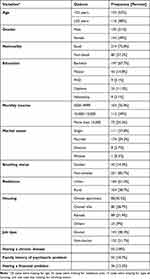 |
Table 1 The Demographics of 294 Healthcare Workers from Jazan, Saudi Arabia |
Table 2 summarizes the utilization and perceptions of the participants regarding the use of WhatsApp in clinical settings. More than 90% claimed that they were currently members of work-related WhatsApp groups, while the majority of participants (58%) indicated that the use of WhatsApp for work purposes increased their overall utilization of the application. The majority of participants also stated that they checked their work-related WhatsApp groups prior to going to sleep (62%). More than half the sample further indicated that they did get contacted via WhatsApp for work purposes outside of working hours or at weekends. Additionally, 46% of participants claimed they did get contacted via WhatsApp for work purposes during vacation, and 32% believed they would be penalized if they did not respond to task orders delivered via WhatsApp.
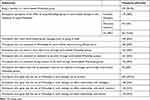 |
Table 2 The Features and Perceptions of 294 Healthcare Workers Regarding the Utilization of WhatsApp in Their Clinical Settings |
When the participants were asked whether the use of WhatsApp in work-related settings could be stressful, nearly 70% agreed that it could. More than half of the sample agreed that WhatsApp use for work purposes could affect their relationships with colleagues and family members. Finally, 47% agreed that the use of WhatsApp for work purposes could affect their relationships with friends.
Assessments on the levels of depression, anxiety, and stress among the recruited sample indicated that 48.6% had abnormal levels of depression, 55.8% had abnormal levels of anxiety, and 63% had abnormal levels of stress. Tables 3–5 present the associations between the demographic factors and the presence of depression, anxiety, and stress respectively. None of the factors tested reached statistical significance when assessing their association with depression. However, nationality and income level were associated with the presence of anxiety, and nationality and housing type were associated with the presence of stress (p values of <0.05).
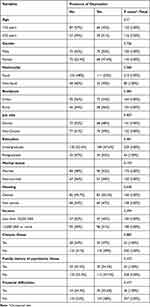 |
Table 3 The Distribution of Depression Among a Sample of 294 Healthcare Workers from Jazan, Saudi Arabia |
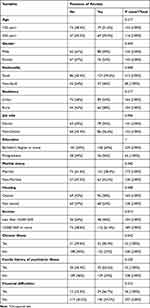 |
Table 4 The Distribution of Anxiety Among a Sample of 294 Healthcare Workers from Jazan, Saudi Arabia |
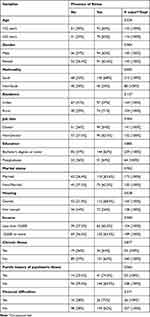 |
Table 5 The Distribution of Stress Among a Sample of 294 Healthcare Workers from Jazan, Saudi Arabia |
Table 6 depicts the findings of the logistic regression regarding the association between the presence of depression, anxiety, and stress and the perceived social impact of WhatsApp among the participants. The results indicate higher odds of depression, anxiety, and stress among participants who agreed that WhatsApp use in work-settings could be stressful and those who agreed it could affect relationships with colleagues, friends, and family members (P values of <0.05); however, the association between depression and agreeing that the use of WhatsApp for work-related purposes was stressful reached a marginal significance level (P value of 0.08).
Discussion
This cross-sectional study of healthcare workers in hospital settings in the Jazan region of Saudi Arabia was carried out to investigate the association between WhatsApp use for work-related purposes and levels of depression, anxiety, and stress. Nearly half of the recruited sample was assessed as having abnormal levels of depression, anxiety, and stress. WhatsApp use for work-related purposes in the recruited sample was high. The majority of participants indicated that using it in this context could be stressful, while nearly half claimed it could affect their relationships with colleagues, family members, and friends. Higher odds of depression, anxiety, and stress were detected among those who agreed that WhatsApp use for work-related purposes could be stressful and harmful to social relationships.
Our findings suggest that WhatsApp, though promoted as a suitable social application in clinical settings, may have a harmful impact on the mental wellbeing of healthcare workers and may be labeled as a stressor. Detecting higher odds of depression, anxiety, and stress among healthcare workers who agreed that the use of WhatsApp for work-related purposes could be stressful and have a negative social impact suggests the presence of an adverse effect on the mental health of employees. Nonetheless, due to the retrospective nature of the current study, it is unclear whether having depression, anxiety, or stress induce the belief that WhatsApp use for work purposes has a negative impact on mental health, or whether perceiving that its use in this context is stressful and harmful to relationships with others increases the risk of depression, anxiety, and stress. It is nevertheless possible to argue that the potential harmful effects of WhatsApp use in clinical settings may increase the risk of mental illness among healthcare workers who have lower resiliency and ability to cope with stress in these settings in the first place.
Studies that assess the impact of WhatsApp use in work settings among healthcare workers on levels of depression, anxiety, and stress are currently lacking. However, WhatsApp, as with any social media application, has the potential of facilitating communications between countless numbers of individuals, and using the application for work-related purposes might further augment the level of engagement with it. Due to the ease of contacting recipients via WhatsApp (given that it is installed in mobile devices and utilizes personal mobile numbers for registration), a high influx of messages, whether work-related or not, may further distract healthcare workers from other official channels of communication and increase their risk of burnout.
Research assessing the association between mental health and social media use in Saudi Arabia is limited. One study included 385 participants with a mean age of 22.5 ± 2.6 years and concluded that students’ mental health was significantly negatively affected by the use of social media.25 Moreover, Al Hamad and Al Amri conducted an investigation into the association between social media use and symptoms of depression in adults in Riyadh, Saudi Arabia. They recruited a sample of 467 participants with a mean age of 27.0 ± 10.9 years and found that among people who use social network sites excessively and for long periods of time, there was a significant prevalence of moderate to severe.24 These findings support ours where prolonged use of WhatsApp due to work-related demands can be associated with a negative impact on mental health, especially among those with a negative attitude toward its use in work-related settings.
The impact of WhatsApp use for work-related purposes on the mental health of healthcare workers, though not measured in the current investigation, can be postulated as varying according to countries and work settings owing to legal and cultural discrepancies. WhatsApp is a highly popular social media application in Saudi Arabia and, as with any other digital channel of communication, is regulated by anti-cybercrime laws.26 Employees engaging in person-to-person communication or administrators of WhatsApp groups can be held responsible for the criminal use of the application by being issued penalties, such as in the form of fines or imprisonment. Because WhatsApp is primarily designed for social communication purposes, its use in work settings may increase the risk of leaking sensitive work-related information to those who are not intended recipients – for instance, if it is shared by mistake – and could have legal consequences and further augment the likelihood of stressful events. Moreover, using WhatsApp could violate privacy as some users might share personal and private materials with recipients in work settings, either on purpose or in error, and this could lead to the escalation of stress and anxiety.
It may be worth noting that the mental health repercussions of using social media in Saudi Arabia, including WhatsApp, cannot be separated from the religious and cultural norms of the Saudi community. These norms have influenced numerous aspects of the lives of these people and have potentially resulted in the conservative use of WhatsApp and other social media applications, which may have prompted users to engage cautiously with the application either in social or work-related settings so as to avoid consequences that may further exacerbate stress levels and increase the risk of suffering with mental illnesses.
Strengths and Limitations
Our investigation had multiple strengths and weaknesses. Its main strength was the identification of WhatsApp as a potential stressor for workers in healthcare settings despite the cumulative evidence promoting its use. This study utilized multistage probability sampling to ensure the appropriate representation of workers, and recruitment was carried out in the clinical settings to ensure reducing chances of selection bias. Because WhatsApp is heavily used in Saudi Arabia, it is possible to generalize the findings from the current investigation to other healthcare and non-healthcare work settings. However, a weakness of the study was the retrospective nature of its investigation and its inability to assess the temporality of the association between the use of the WhatsApp application and mental health. Finally, although data collection was performed anonymously, this investigation may had been viewed as having an administrative system evaluation nature by some employees, and thus, increasing chances of some employees to hesitate to respond to some questions, leading to multiple missing data. Nonetheless, after performing the descriptive analysis, missing data per item did not exceed 10% of the recruited sample except for one item assessing the impact of using WhatsApp for work-related purposes on the frequency of overall utilization of the application (missing data reached 11.5%).
Conclusion
Our study identified WhatsApp use for work-related purposes as having a potentially harmful impact on healthcare workers, especially among those who perceived its use in as a stressor and an influence on occupational and social relationships. Further research, especially of a qualitative nature, is needed to investigate why some might perceive the application as a stressor. The findings of the study indicate that WhatsApp, though not an officially established channel of communication among employees in clinical care settings in Saudi Arabia, is nevertheless heavily used by healthcare workers and can act as a diversion from the use of official communication systems. It is encouraged to either develop new or utilize existing systems for communication between healthcare workers in clinical settings that combine some features available in WhatsApp and to simultaneously ensure they meet the legal and occupational requirements of healthcare establishments.
Author Contributions
All authors made a significant contribution to the work reported, whether that is in the conception, study design, execution, acquisition of data, analysis and interpretation, or in all these areas; took part in drafting, revising or critically reviewing the article; gave final approval of the version to be published; have agreed on the journal to which the article has been submitted; and agree to be accountable for all aspects of the work.
Disclosure
The authors report no conflicts of interest in this work.
References
1. Mental disorders. Available from: https://www.who.int/news-room/fact-sheets/detail/mental-disorders.
2. VizHub. GBD results. Available from: https://vizhub.healthdata.org/gbd-results/.
3. Mental health and COVID-19: early evidence of the pandemic’s impact: scientific brief; 2022. Available from: https://www.who.int/publications/i/item/WHO-2019-nCoV-Sci_Brief-Mental_health-2022.1.
4. NIMH. Chronic illness and mental health: recognizing and treating depression. Available from: https://www.nimh.nih.gov/health/publications/chronic-illness-mental-health.
5. Mental health at work. Available from: https://www.who.int/news-room/fact-sheets/detail/mental-health-at-work.
6. Søvold LE, Naslund JA, Kousoulis AA, et al. Prioritizing the mental health and well-being of healthcare workers: an urgent global public health priority. Front Public Health. 2021;9:514. doi:10.3389/FPUBH.2021.679397/BIBTEX
7. Ahmed YA, Ahmad MN, Ahmad N, Zakaria NH. Social media for knowledge-sharing: a systematic literature review. Telemat Informatics. 2019;37:72–112. doi:10.1016/j.tele.2018.01.015
8. Statista. Most used social media 2021. Available from: https://www.statista.com/statistics/272014/global-social-networks-ranked-by-number-of-users/.
9. Chen IH, Strong C, Lin YC, et al. Time invariance of three ultra-brief internet-related instruments: Smartphone Application-Based Addiction Scale (SABAS), Bergen Social Media Addiction Scale (BSMAS), and the nine-item Internet Gaming Disorder Scale- Short Form (IGDS-SF9) (Study Part B). Addict Behav. 2020;101:105960. doi:10.1016/J.ADDBEH.2019.04.018
10. Yekefallah L, Dehghankar L, Razaghpoor A, Hasannia E, Hosseini N, Mafi M. The prevalence and predictive factors of internet addiction and its relationship with emotional intelligence among medical students. Soc Heal Behav. 2019;2(4):145. doi:10.4103/SHB.SHB_17_19
11. Barayev E, Shental O, Yaari D, et al. WhatsApp tele-medicine - usage patterns and physicians views on the platform. Isr J Health Policy Res. 2021;10(1). doi:10.1186/S13584-021-00468-8
12. Al-Hajri QR, Alfayez A, Alsalman D, et al. The impact of WhatsApp on the blood donation process in Saudi Arabia. J Blood Med. 2021;12:1003–1010. doi:10.2147/JBM.S339521
13. Sartori AC, Lucena TFR, Lopes CT, Bernuci MP, Yamaguchi MU. Educational intervention using WhatsApp on medication adherence in hypertension and diabetes patients: a randomized clinical trial. Telemed J E Health. 2020;26(12):1526–1532. doi:10.1089/TMJ.2019.0305
14. Koparal M, Ünsal HY, Alan H, Üçkardeş F, Gülsün B. WhatsApp messaging improves communication in an oral and maxillofacial surgery team. Int J Med Inform. 2019;132:103987. doi:10.1016/J.IJMEDINF.2019.103987
15. Siegmund LA. Social media in occupational health nursing: helpful or harmful? Workplace Health Saf. 2020;68(9):408–414. doi:10.1177/2165079920935779
16. Gebbia V, Piazza D, Valerio MR, Firenze A. WhatsApp Messenger use in oncology: a narrative review on pros and contras of a flexible and practical, non-specific communication tool. Ecancermedicalscience. 2021;15. doi:10.3332/ECANCER.2021.1334
17. Mars M, Morris C, Scott RE. WhatsApp guidelines - what guidelines? A literature review. J Telemed Telecare. 2019;25(9):524–529. doi:10.1177/1357633X19873233
18. Masoni M, Guelfi MR. WhatsApp and other messaging apps in medicine: opportunities and risks. Intern Emerg Med. 2020;15(2):171–173. doi:10.1007/S11739-020-02292-5
19. Bernal-Ruiz C, Rosa-Alcázar AI. The relationship between problematic internet use, WhatsApp and personality. Eur J Psychol. 2022;18(1):6–18. doi:10.5964/EJOP.2051
20. Riehm KE, Feder KA, Tormohlen KN, et al. Associations between time spent using social media and internalizing and externalizing problems among US youth. JAMA Psychiatry. 2019;76(12):1266–1273. doi:10.1001/jamapsychiatry.2019.2325
21. Woods HC, Scott H. #Sleepyteens: social media use in adolescence is associated with poor sleep quality, anxiety, depression and low self-esteem. J Adolesc. 2016;51(1):41–49. doi:10.1016/j.adolescence.2016.05.008
22. Alsabaani A, Alshahrani AA, Abukaftah AS. Association between over-use of social media and depression among medical students, King Khalid University, Kingdom of Saudi Arabia. Egypt J Hosp Med. 2018;70(8):1305–1311. doi:10.12816/0044639
23. Antony MM, Cox BJ, Enns MW, Bieling PJ, Swinson RP. Psychometric properties of the 42-item and 21-item versions of the Depression Anxiety Stress Scales in clinical groups and a community sample. Psychol Assess. 1998;10(2):176–181. doi:10.1037/1040-3590.10.2.176
24. AlHamad NS, AlAmri K. The association between social media use and depressive symptoms among adults in Riyadh, Saudi Arabia. J Fam Med Prim Care. 2021;10(9):3336. doi:10.4103/JFMPC.JFMPC_697_21
25. Alsubaie S, Almehery R, Alsharif R, Shmashir A, Alshehri M. The effect of social media content on mental health and well-being among King Khalid University students in Saudi Arabia. Int J Med Dev Ctries. 2021;242–248. doi:10.24911/IJMDC.51-1606916560
26. Rule details. Available from: https://laws.boe.gov.sa/BoeLaws/Laws/LawDetails/25df73d6-0f49-4dc5-b010-a9a700f2ec1d/1.
 © 2023 The Author(s). This work is published and licensed by Dove Medical Press Limited. The full terms of this license are available at https://www.dovepress.com/terms.php and incorporate the Creative Commons Attribution - Non Commercial (unported, v3.0) License.
By accessing the work you hereby accept the Terms. Non-commercial uses of the work are permitted without any further permission from Dove Medical Press Limited, provided the work is properly attributed. For permission for commercial use of this work, please see paragraphs 4.2 and 5 of our Terms.
© 2023 The Author(s). This work is published and licensed by Dove Medical Press Limited. The full terms of this license are available at https://www.dovepress.com/terms.php and incorporate the Creative Commons Attribution - Non Commercial (unported, v3.0) License.
By accessing the work you hereby accept the Terms. Non-commercial uses of the work are permitted without any further permission from Dove Medical Press Limited, provided the work is properly attributed. For permission for commercial use of this work, please see paragraphs 4.2 and 5 of our Terms.

